#he originally had a negative charisma/charm score
Explore tagged Tumblr posts
Note
red for avery?
🔴 Red - What is a trait your OC has that those around them don't see very often? Is it seen by a rare few or completely overlooked?
He actually enjoys and is good at small talk, being charming, and building a rapport with people, but he works night shift gas station customer service and lives in a tinyass town trying to avoid a cult that wants him dead. He's friendly with the other people in town but he's trying not to get close to anyone or make himself noticeable (first mistake: moving to a tinyass town). (To be fair to him, though, the cult didn't catch up for like six months.) (And the townspeople like him so much that they didn't even really blink at the subsequent Horrors (and murder) (and arson) that he and the cult presence went through.) (They think he got possessed by an an angel to rid the town of evil (he now shares a brain with headmates AND an actual literal demon)).
orb oc ask game
#feel free to send some more in but im travelling starting tomorrow so i wont get to anything for a bit#oc tag avery#banana made a post#banana answers things#he originally had a negative charisma/charm score#but then headmate avery fronted while we were at work and i was like wow#is this what it's like to not constantly struggle and feel awkward with small talk with customers? WILD#so then i went to my gm like hey. God Told Me that avery would be better at talking#can i up his charm score (in exchange for lowering some other stuff)#and they were like#yeah go for it. this party needs someone who can talk to people#LMAO#sorry for all the parentheses (i'm not) they arent really related to the question#but i find the town's perception vs reality so funny still
3 notes
·
View notes
Text
Why ‘The Karate Kid Part II’ Deserves More Respect
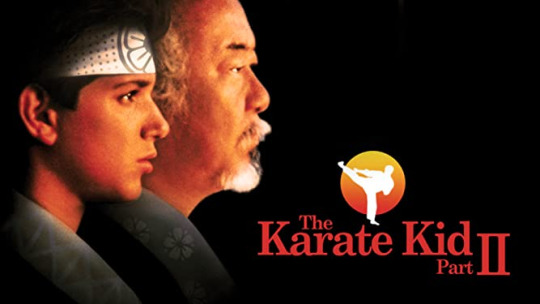
So guess what film I finished watching today? Of course, the Karate Kid franchise is considered iconic mainly for its first entry; Wax on Wax off, Skeleton fights, Sweep the Leg and the Crane Kick all cemented its legacy that allowed Cobra Kai to also be such a success. But imagine my shock when the approval rating on Rotten Tomatoes for Part II is 45% - 21% lower than the Jaden Smith ‘The Karate Kung Fu Kid’ version (and Part III is scored 15%, which is also super harsh but hard to debate outside of the magnificence of Terry Silver). Originally this was just gonna be a general post of how much I enjoyed retreading Part II, but upon seeing that score I had to give it my ‘Deserves More Respect’ posts.
It is an off-chance, but if you haven’t watched this film there will be spoilers within, I encourage you to watch it before reading, and maybe watch it again if you have so it’s fresh in the mind
Let’s start with a controversial point shall we? There are several parts where Part II is actually better than the original. Now I know! There’s a lot about the original which is iconic, but nostalgia does blind you to other shortcomings and while it’s easy to sell the first part because of its mystique, a sequel has the added pressure of rising above and developing on old and new themes set by the predecessor. The Premise In case you decided against refreshing your memory. Karate Kid Part II starts with a recap of Part I, a bit of content that was meant to be Part I’s final scene (in the script, not for filming) and then a timeskip. Ali with an i is gone - brutally dumping Daniel for some Football Player before Senior Prom and after crashing his car, Daniel’s mother is in Fresno for work and Miyagi has received a letter from his home Okinawa in news of his father’s fading health. The stage is set for Daniel and the audience to learn more about the iconic Mr. Miyagi and the life he left behind. Okay, so there is bad in this film Part II deserves respect, but it’s not perfect. It definitely gets messy near the end with Daniel’s antagonist Chozen, he mainly took beats from Johnny Lawrence in physically confronting Daniel when he could with a bunch of no-named goons and he fought pretty similarly to Johnny in catch counters and leg strikes. The opening recap did take a lot of time too, while the ending remained somewhat abrupt having just beaten up Chozen to embrace Kumiko (who had a delayed recovery after being punched once). While not bad, a fair amount of retreaded content felt like downgrades of the original; Chozen and Sato lacked the charisma of Johnny and Kreese, the crane kick was far more impressive than the drum technique and the Tournament setting was grander than the O-Bon festival. But, there are Iconic Moments in this film too Part I may have the Crane Kick and the Skeletons and the Training and Sweep the Leg. But people may forget that Part II had awesome moments too.
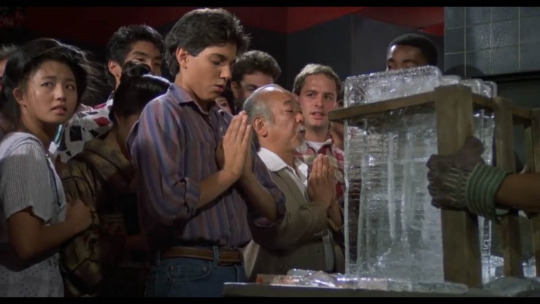
Like Daniel chopping through 6 Sheets of Ice! If that isn’t one hell of a power play I don’t know what is. It is a moment genuinely impressive in and outside of the 80s cheese universe of Karate Kid, and it gets referenced in Season 2 of Cobra Kai.
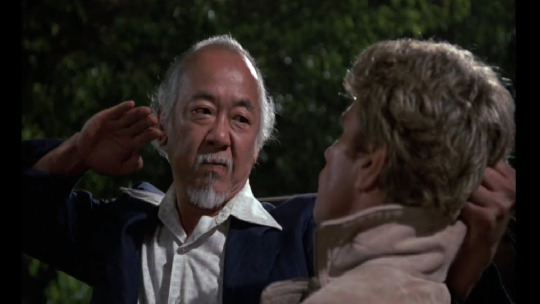
Also referenced in Season 2 is Miyagi vs Kreese. While this is the intended ending for Part I, it certainly acted better at the start of Part II, especially given that is foreshadows the situation Daniel finds himself in at the end of the movie. This moment is equally iconic as it completely encapsulates the character of both senseis - Kreese the confident brute brought to a sniveling mouse when size and power failed him and Miyagi the cool-headed and vastly more intelligent fighter still with the cheeky prankster lightness to him as he honks the scared shitless Kreese on the nose. Perfect.
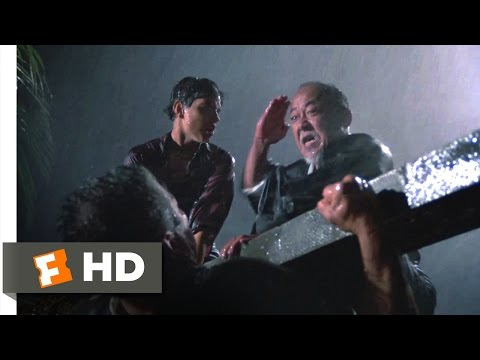
While I did want to cite the Tea Ceremony as well I think the more iconic moment for Part II had to be Miyagi chopping the log during the storm. The storm itself is a very well-done scene which unmasks several characters in the face of adversity. True tension, worry and stakes are sold as the village are in danger of the cruel whims of nature, an act which is all too real for Sato when the house he’s in collapses on him in the calm before his scheduled deathmatch with Miyagi. Not only is this again some great foreshadowing by the rule of three (Daniel asking if Miyagi can chop a log like Sato is doing with a banner and then Miyagi and Sato meeting and seeing Sato fail to chop a log) it proves a pivotal point where Sato turns from aggrieved antagonist to repenting ally. A great show of power and friendship as Miyagi metaphorically breaks the rift between their friendship that weighs Sato down. Okay, we hear you, but how is it better? I do have to preface that I do still love Part I, I have to because in pointing out where Part II is better I have to pick at Part I’s faults. While the ending is messy Part II definitely has much better pacing, until the skeletons scene Part I doesn’t really pick up because it has to set up, Part II while it does recap doesn’t need to worry about it. Giving Miyagi the main plot was definitely Part II’s strongest suit. Part I profited from Miyagi being the ‘mysterious old teacher’ but learning a lot more about his humanity and history was engrossing and it allowed positive development for Miyagi and Daniel, especially their bond as a surrogate father and son when Daniel personally goes out of his way to support Miyagi on a very personal matter. The main characters maintain their charm as well, still a lovely array of life lessons in Part II more than just finding balance, Miyagi teaches Daniel through words and action on taking time to breathe, to refocus when imbalanced, to forgive rather than to harbour hate, mercy, selflessness and humbleness
“never put passion before principle. Even if win, you lose.” - Mr. Miyagi
The scenes involving Miyagi and his father were some of the most deep and emotive of the series up until Cobra Kai, some still haven’t been topped such as Miyagi’s dad’s first words to his son or when Daniel talked about when his father died. And say what you will about Chozen, he does have a lot of Johnny vibes but a lot of the character we believed was Johnny due to nostalgia goggles was more fitting of Chozen’s manner. The story did a great job in making sure Chozen was always an asshole, at times Johnny did at least display honour and grace but Chozen was always sore about stuff and quick to claim dishonour even when he was in the wrong. Contrary to Johnny it’s more about his family than it is about a girl, which allowed a lot more freedom in the plot. Whether you felt Elizabeth Shue’s Ali with an i was prettier than Tamlyn Tomita’s Kumiko is up to personal preference, but the messy-haired Kumiko definitely had a slightly improved presence in Part II than Ali did, with actual focus on her own feelings outside of attraction to Daniel, her ambition to become a dancer directly linking to the O-Bon Festival - which in turn related to the Drum technique - as well as the delicately beautiful Tea Ceremony scene and actually contributing to the final fight (granted Ali wouldn’t be allowed to). Also Daniel didn’t try to eat her face which is a general improvement to the romantic subplot, extra applause has to go to Tomita here too because this was legitimately her first role - Shue had her second so that’s impressive too - and both women had good careers going forward. The increased stakes definitely worked in the favour of Part II as well, as sequel culture is forced to do, but by moving to Okinawa (actually filmed in Hawaii) we opened the door to better suit Miyagi’s world while keeping Daniel the fish out of water. I can’t speak too much for appropriation because there is still kinda some ‘white saviour’ undertones but I didn’t feel like Japan was treated negatively in this light, its culture of the O-Bon Festival and the Tea Ceremony was treated with the utmost respect and explained without pandering, the flute music had definitely stepped up its game for the soundtrack as did the imagery. Can also appreciate that Daniel does go for the Crane kick when fighting Chozen but is parried. Added hat tip has to go to costuming too. A lot of costumes would have to have distinct Kamon such as Sato’s twin fish and Miyagi’s bonsai on a lot of their clothing
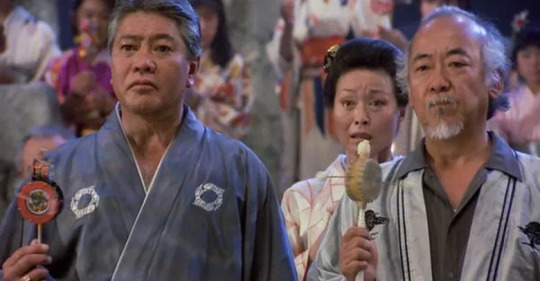
Between Sato and Miyagi the colours of their clothes often code their emotions towards each other, with Sato usually in grey and Miyagi in white or cream, when Sato and Miyagi prepare for death they are in black and when Sato wants forgiveness he moves to a lighter shade. While Part I also used black and white to differ Johnny and Daniel, Part II put Chozen and Daniel in the more Japanese-themed Red and Blue. While both men wear red, blue and whites at time, Chozen’s clothes almost devolve from the white he debuts in as his darker side comes out before flat out embracing yellow after his chance to prove his honour in the storm is refused (and he’s in white then), while Daniel often moves to Red or red tones even in his blue shirt. Kumiko also moves from white to blue, sometimes even purple, in set up to the final fight to have the primary colours stand out in the colourful crowd of the O-Bon festival, but even in the blue Kumiko had red to pair her connection with Daniel. Also her Yukata at the festival is just stunning, the Great Wave off Kanagawa print is a nice touch.
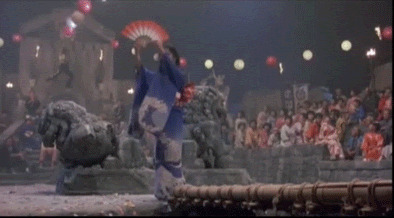
Anything else we should know? It might not be much else about the film itself I can tell you, but I do appreciate something I’m starting to call ‘The Rocky Connection’ when it comes to Karate Kid. Like Part I’s ‘You’re the Best (Around)’ was shortlisted for Rocky III, Part II’s song ‘Glory of Love’ was shortlisted for Rocky IV’s theme, losing to ‘Hearts on Fire’, Bill Conti also chose to score this film instead of Rocky IV. I like to pair this with Daniel’s Rocky-esque character, he has that same kind of swagger but a lot more naive and childlike. Martin Kove also gets a nod because those bleeding hands were legit, he had an accident on-set and the footage was kept for the final cut. Tamlyn Tomita wasn’t the only film debut for Part II, B.D. Wong of...well, several famous roles including but not limited to Shang in the animated Mulan, Dr. Wu in the Jurassic Park franchise, Hugo Strange in Gotham and many more, also had his debut here in a minor speaking role when he’s handing out flyers for the dance party to Kumiko and Daniel before the Ice Chopping Scene. So, why does it deserve respect A film that adds to a beloved character in a respectful fashion without having really any god awful moments does not deserve a 4.5/10 rating. It may not have as emphatic an ending or as great a villain but it has a captivating plot and a good pace, better stakes and much more emotionally driven and responsive scenes. A lot of effort and dedication went into this film to explore new dimensions of the main characters in a fashion which was enjoyable and at times heartwarming. And characters are given human moments, even Miyagi confesses himself not to be perfect and it keeps each character grounded. Even to this day parts of Part II are remembered fondly rather than the campness that Part III had outside of Terry Silver and his magnificent ponytail, the fondness also continues to reflect in Cobra Kai with homages and fan theories of Daniel going to Okinawa again and even re-encountering Chozen. Not to mention it grossed $113m on a $13m budget and got nominated for a Best Original Song Oscar (losing to Top Gun) Part II was a good and enjoyable film which deserves far more credit than to be rated this low, for that it deserves respect.
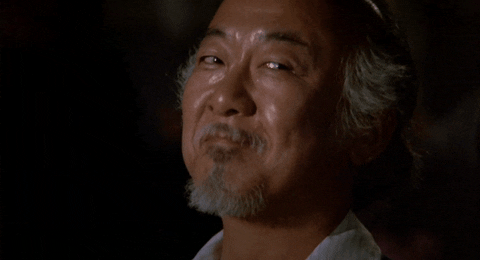
#karate kid#karate kid part ii#karate kid 2#daniel larusso#ralph macchio#mr miyagi#pat morita#chozen#yuji okumoto#kumiko#tamlyn tomita#sato#danny kamekona#john kreese#martin kove#johnny lawrence#billy zabka#yukie#nobu mccarthy#cobra kai
24 notes
·
View notes
Text
My Fan-Cast for the Live-Action Remake of The Swan Princess
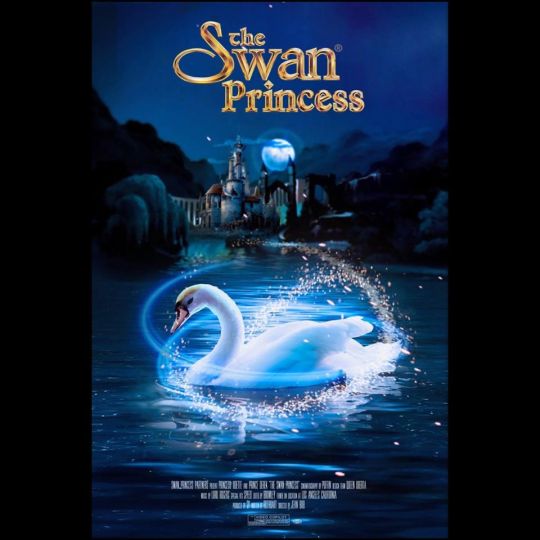
As some of you might be aware, there is going to be a potential live-action remake of the 1994 animated classic, The Swan Princess. The original movie is one of my all-time favorite movies, not just in animation but in general. It has fantastic songs, a lovely score, great characters, beautiful animation, a cool villain, awesome action scenes, funny comedy, and an engaging romance. So I am both very excited and cautious about the live-action remake, due to how much the animated movie means to be (I was actually born only twenty-one days before the movie was released in theaters). I don’t want it to be an exact copy but rather tell it in a new way while staying true to the original, as well as justify its existence. The creators of the original Swan Princess, it’s two hand-drawn sequels, and its terrible CGI movies are wanting to make a live-action remake of the classic. They are really awesome with how they interact with their fans and even accept that most of the fans really hate the computer animated movies. They appreciate praise and criticism, unlike some studios that only want praise. Anyway, they created a concept trailer, which is pretty much like what a pilot for a TV series is. It’s to give an idea of what it could be rather than being a finished product, so the actors in it aren’t necessarily going to be in the actual movie, as well as the effects/CGI not being finished. They are looking for the right studio to help make the film a reality. To get an idea, here is the concept trailer.
youtube
Anyway, despite being a little nervous about the movie, I am also excited for it because I want to see how they bring it to life. Besides, just like many fans, I’d much rather see a live-action remake of The Swan Princess than one of their computer animated movies, but I won’t go into that. Something I will go into is my dream-cast for this movie. As many of you know, I have a thing for doing my own fan-casts for movies. I’ve even made a video of my fan-casting choices as well, which I will include at the very end of this, which shows their acting and singing abilities. However, I did not include the animal sidekicks (Jean-Bob, Speed, and Puffin) or Bromley and I replaced Bridget (The hag and Rothbart’s little minion) with Rothbart’s daughter from the original Swan Lake ballet, the Black Swan herself, Odile. Let me be clear, I have nothing against those characters AT ALL. I love all of them! However, I feel like their very cartoony and Looney Tunes style of humor wouldn’t work in a live-action setting. So without further ado, here are my casting choices.
Jennifer Morrison as Odette’s Mother

If you have seen Disney’s live-action remakes, you’d know that they have a thing for actually showing the dead mothers of Disney Princesses. Cinderella’s mother, Belle’s mother, they revealed that Ariel’s mother is going to be in the live-action remake of The Little Mermaid, and while Jasmine’s mother didn’t make a physical appearance, she was mentioned a lot. So why not do the same with The Swan Princess? It could be added to the prologue and have her die giving birth. Jennifer Morrison has proven in Once Upon a Time that she is really incredible in labor scenes. Emma giving birth to Henry is considered one of Jennifer Morrison’s best performances, if not her absolute best. She also has a beautiful singing voice, which could make for a lovely new song in the movie, like a lullaby to Odette before she dies from childbirth. Maybe it would be one that could foreshadow Odette’s journey like the song “All is Found” from Disney’s Frozen II. Plus, Emma Swan is basically the Odette of the Once Upon a Time world. She’s too old to play Odette but she can still play her mother.
Kevin Kline as King William
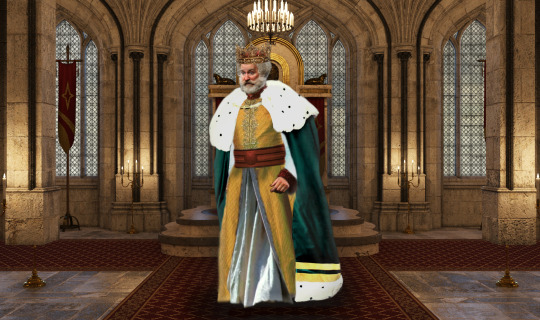
I instantly thought of him for King William because of his role in the live-action remake of Beauty and the Beast. He showed such tenderness and a loving fatherly nature as Maurice that he would be perfect for King William, who is protective of nurturing towards Odette. He can also be funny and charming, which is another part of King William. He’d be able to show what a loving father and an entertaining character he is, which will make his death all the more heartbreaking and you could even show flashbacks to Odette’s childhood that shows how much she misses her father. The live-action remake should show more of how Odette is traumatized by her father’s death and how she didn’t get to say goodbye, hug him one last time, or tell him that she loves him for the very last time (But still have the main focus be on her relationship with Derek and try to develop it further). So it would add a layer of depth and complexity to Odette’s character and showing some flashbacks of their bond will make her refusal to give Rothbart her father’s kingdom even more powerful than it already is. She’d also wonder if she’d be the kind of queen he wanted her to be or he would be proud of, which he would be because she’d be putting the needs of her people ahead of her own by not giving into Rothbart. Kevin Kline is a strong actor that would exemplify everything that would make for a great King William and help with Odette’s own journey as a character with her wanting to make him proud. Not to mention that Kevin Kline has Broadway experience and can really sing. He actually has a better voice than what he had displayed in the remake of Beauty and the Beast, which will be important for the musical sequence, “This is My Idea.”
Josh Gad as Chamberlain
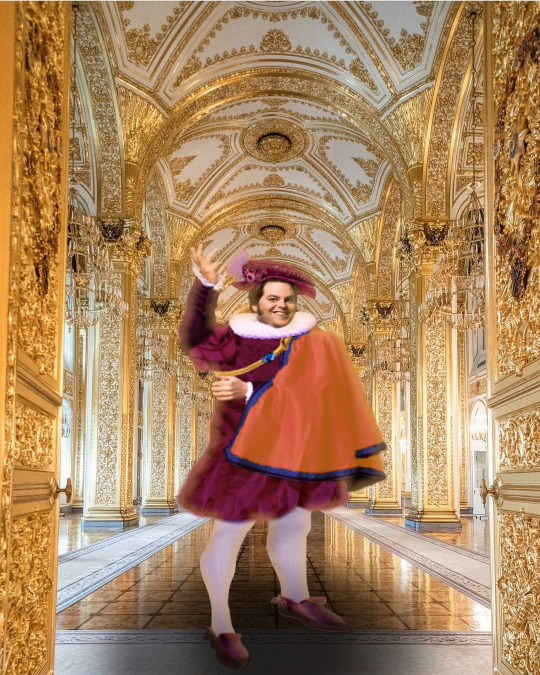
I can’t imagine anyone else as Chamberlain! I mean, he’s flamboyant, he’s hilarious, he doesn’t rely on shouting or being loud for humor, he can be subtle, he can act, he can dance, he has so much charisma, and he can sing. Josh Gad IS Chamberlain! His credits speak for themselves with his Broadway work, voice acting, and film work. Sure, his singing voice is higher than Chamberlain’s but he actually can sing in a lower register. Even if he can’t, he still has a phenomenal voice and so much energy that it wouldn’t really matter. He’d bring alive the musical sequence, “Princesses on Parade.” He’d be able to make the humor of Chamberlain feel like it’s more natural in the live-action remake the same way he managed to make Lefou feel more grounded in the live-action remake of Beauty and the Beast.
Sandy Duncan as Queen Uberta
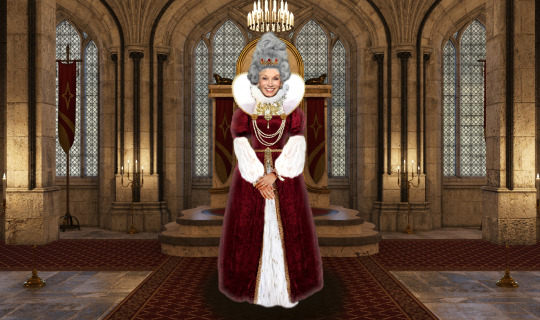
This won’t take much explanation because of the fact that she is the original voice actress for Queen Uberta in the original film. She’s the right age to play her in live-action and even said she could do Uberta now. She’s known as “Funny Girl, Sandy Duncan” for a reason. She will be able to bring Uberta to life with her humor, charm, quirkiness, and charisma. But also show her caring and motherly side. Besides, it would be a great callback to the original movie to have her reprise her role in live-action.
David Hyde Pierce as Lord Rogers
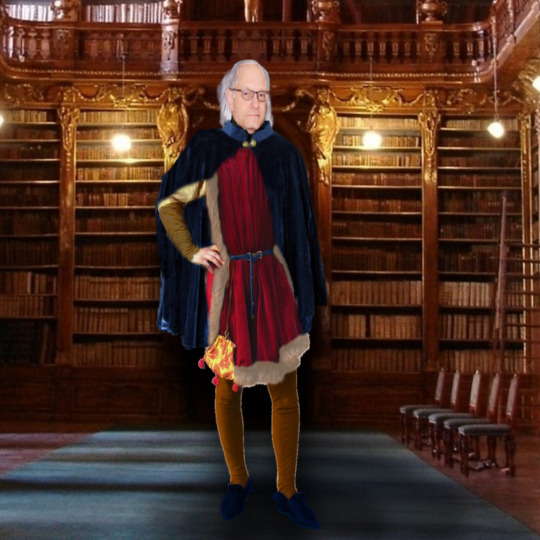
This would be absolutely PERFECT! I mean, if you have seen him in his most iconic role, Niles Crane from the sitcom Frasier, you’d know he would be able to capture the dry wit that Rogers is known for. He can also do physical comedy as well, which Rogers does some of. Not to mention he can also pull off the wise and caring mentor aspect that Rogers is to Derek. He has such an appealing sounding speaking voice that is 100% right for Rogers. He’s the right age and still has a lot of energy in him, despite his age. He also has Broadway experience, so he’d be able to pull off the singing aspect as well.
Bella Thorne as Odile

I know a lot of people hate on Bella Thorne, but that doesn’t change what a brilliant actress she is with A LOT of experience. She’s been acting since she was six-years-old and even played a villain at the age of eleven (Maybe even younger) in the movie Forget Me Not. She has experience playing villains in movies like The Duff, You Get Me, The Babysitter, and The Babysitter: Killer Queen. She can be very frightening, especially in You Get Me, despite the film not being very good. Just the look of her eyes shows how intimidating she is. She can be very sassy and make it come off as very natural and not feel forced. She puts her heart and soul into every role she’s in. It’s always clear that she is giving it her all. While her movie Infamous was received negatively, her performance received critical acclaim. One critic in particular compared her talents to award winning actress, Sandra Bullock. Her acting talents have even been praised by award winning actress, Jessica Chastain, as well as many other celebrities that just loved working with her (Which is pretty much everyone she’s worked with). She’s very seductive, which Odile is known for, and is absolutely gorgeous. She also has a lovely singing voice. Nothing great but still good enough for a movie musical. If they included her in the movie and decided to make her a redeemable villain, Bella Thorne would be able to show that with her wide range of acting. Crying real tears is something that comes very easily to her. She’d be able to show the complexity and dimensions of the character.
Either way, it makes much more sense to have Odile be in the role of the Black Swan instead of Bridget. The Fake Odette is supposed to act seductive and also give Derek some hesitation to show that he has a feeling something isn’t right. It shows how he isn’t only interested in Odette because of her looks. This makes more sense with Odile because her behavior and mannerisms should be more like her own rather than like Odette’s, which doesn’t work with Bridget. In all the scenes that Bridget is in, she’s very comedic, wacky, silly, and over-the-top in her behavior and mannerisms. That makes her entertaining, but it doesn’t make sense in the context of the Black Swan trick. Just an observation I have. Not to mention that it could give Rothbart more motivation for wanting the kingdom, because of his love for his daughter. Besides, a lot of fans are hoping that Odile will be in the live-action remake. In my opinion, Bella Thorne is the only real choice for the Black Swan. She’s a phenomenal actress, she’s a good singer, she’s sexy and seductive, and she’s gorgeous. With a major movie like this, she could end up getting an Oscar nomination for Best Supporting Actress and have people finally take her seriously as an actress. I think she’s the most talented actor on this fan-cast list (I don’t care what anyone says) and that is saying something because this cast is phenomenally talented.
Toby Stephens as Rothbart

First of all, I cast a real redhead as Rothbart because I’m not ignoring gingerism like a lot of people are. Second of all, talent is in his blood, since he is the son of critically acclaimed actors, Robert Stephens and Maggie Smith. With brilliant talents like that for parents, you know that he has to be a brilliant talent as well. He is a phenomenal actor with many credits to his name. He’d be able to capture the gruffness of Rothbart but also the class, anger, sinister nature, wit, and energetic charisma of the character. He can also sing, though out of all the actors here, he has the weakest voice. However, his voice suits the character. It’s deep and raspy, which is perfect for the musical sequence, “No More Mr. Nice Guy.” He’s the second most talented actor on here, next to Bella Thorne, which makes sense because villains tend to be the ones to steal the show. Everyone loves a good villain. Honestly, I can’t imagine anyone else as Rothbart but Toby Stephens.
Derek Klena as Prince Derek

I mean, he already has the name for it, though that had nothing to do with this casting choice. He has an incredible singing voice and a lot of Broadway experience. He even played another Non-Disney hero on Broadway in the musical Anastasia as the love interest, Dimitri. YES! I’m aware that Disney bought 20th Century Fox and therefore own Anastasia. However, I still don’t consider Anastasia to be Disney. Anyway, his voice has a love of passion, power, tenderness, and is just the voice of a prince. He also has experience in screen acting and not just stage acting, which are two completely different skillsets. He demonstrates a lot of charm and charisma in his acting, so he’d be able to bring the character to life. When he sings, he shows just what a great actor he is as well as a singer. You can instantly connect with the character he’s playing and what he is feeling/going through. Not to mention that he is really handsome. But I hope that they won’t give Derek that ugly hairstyle that he has in all of the movies.
Demi Lovato as Princess Odette

Now for The Swan Princess herself. I bet some of you think that this is an odd choice because of how Demi is a pop star. However, that doesn’t mean she can’t be a princess. Look at Mandy Moore as Rapunzel in Disney’s Tangled. Besides, look at Demi with blonde hair. She looks exactly like Odette! Demi Lovato’s voice may not be as light as Odette’s usually is, but she still has a voice that would translate very well into the Broadways style music. Her vocal abilities speak for themselves and are undeniably brilliant. Not only that, but she’s a great actress, which a lot of people seem to forget because of how she focuses on her music career. It also wouldn’t be the first time she’s played an elegant princess, since she was in the Disney Channel original movie, Princess Protection Program. I also feel like she’d be able to capture qualities of Odette that people often overlook. Odette in the original trilogy (Especially the first movie) was feisty, strong-willed, and defiant. Demi represents those qualities perfectly in everything she does. She can capture Odette’s kindness and caring nature, since she is such a loving soul, but also manage to represent other qualities that make Odette who she is. She isn’t afraid to go against Rothbart, find a way to get out of her bad situation, and even defy her father in wanting Derek to tell her what he loves about her besides her looks. She even has some experience with voice acting, so she’d be a natural when having to do voice acting for Odette when in her swan form.
She’d also be able to capture the sexy and seductive behavior that is required for when Odile is disguised as Odette. If you have seen any of Demi Lovato’s music videos where she’s very provocative, she’s clearly able to capture that perfectly. Plus, if the movie does have Odile and they cast Bella, it would work because of how Demi and Bella are actually really good friends, so they’d be able to work together to make sure that Demi could imitate the mannerisms that Bella establishes for Odile.
Lets also not forget that she could help write an original song for the movie, which could get an Oscar nomination for Best Original Song. Demi’s songs, more often than not, have a story-telling quality to them. Her songs have her emotions and feeling out on her sleeves for people to know about and sometimes even have something of a character arc. Combine that with a traditional Broadway score by Lex de Azevedo or maybe even with the score from the original Swan Lake ballet by Tchaikovsky. Besides, with her MASSIVE fanbase, she would draw in a LARGE crowd, especially since they would love to see her in a movie musical, particularly one that would have a theatrical release. I wouldn’t be surprised if she got an Oscar nomination for Best Actress.
BONUS MATERIAL:

For some bonus material, I’ve included who I would choose to sing the end credit songs from the original movie, “Far Longer Than Forever” and “Eternity.”
“Far Longer Than Forever”: Jordan Fisher and Coco Jones

These two singing a duet together would be absolutely HEAVENLY! They have absolutely amazing voices with wide and versatile vocal ranges. Jordan Fisher is pretty much a male version of Mariah Carey. Coco Jones is pretty much a younger version of Jennifer Hudson. Not to mention singing the end credit song to a remake of an iconic and beloved animated movie could help her get the recognition she deserves. She was done dirty in Hollywood because of her being a dark-skinned black woman. Singing the end credit version of “Far Longer Than Forever” in the live-action remake could be to her what “Reflection” was for Christina Aguilera. That song is what helped make Christina the massive star she is today, so much so that she came back to sing a new version of the song in the live-action remake of Mulan.
“Eternity”: Anneliese van der Pol
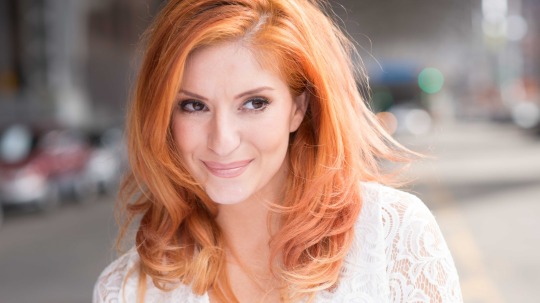
Anneliese van der Pol is such an UNDERRATED talent! She has one of the most amazing voices I’ve ever heard in my life. It’s so powerful, she can seriously belt, has such an old fashioned beauty to her voice reminiscent of singers like Judy Garland and Barbra Streisand that is rare to find nowadays, she can be full-on but also tender, and is a Broadway singer. She would do the song justice and would stay true to the spirit of it. I mean, listen to her cover of the song “Candle on the Water.” Usually with Disney Mania, it’s almost always modern style music to classic Disney songs, however, Anneliese’s cover was in the same style as the original song, which is unique. In fact, her cover was better than the original.
youtube
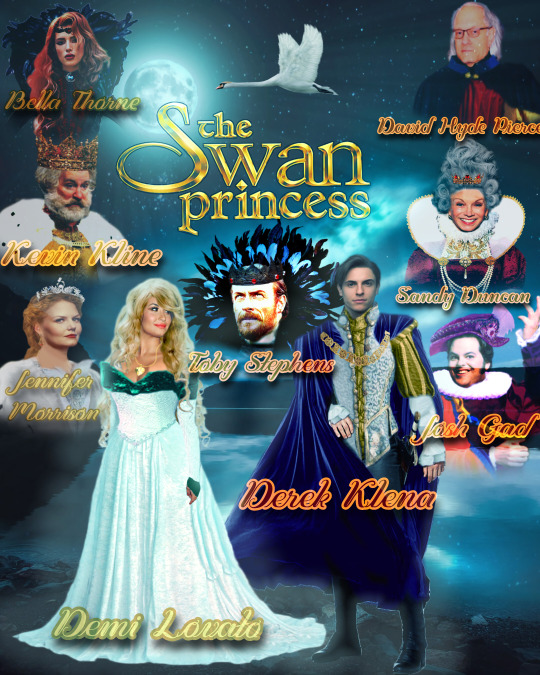
youtube
Lastly, did you know that The Swan Princess has an OFFICIAL Youtube, Facebook, Tumblr, and Instagram? They even interact with fans A LOT! Take a look!
https://www.instagram.com/swanprincessofficial/
@theswanprincessofficial
https://www.youtube.com/channel/UCm_Q3k32sEVQbrANS7-vSjA
https://www.facebook.com/official.swanprincess/
You can even send an email to [email protected] where you can ask a question and it might be chosen for the monthly Chamberg Daily News (Chamberg is the name of Derek’s kingdom).
#Odette#Princess Odette#Prince Derek#Swan Lake#The Swan Princess#Odette and Derek#Rothbart#Odile#The Black Swan#Demi Lovato#Derek Klena#Toby Stephens#Bella Thorne#David Hyde Pierce#Sandy Duncan#Josh Gad#Kevin Kline#Jennifer Morrison#Anneliese van der Pol#Coco Jones#Jordan Fisher#live-action remake#live-action#remake#fancast#fancasting#dreamcast#Dream Cast#swan
8 notes
·
View notes
Text
The GOOD things about the OUAT Finale
The finale for the sixth season and original series of Once Upon a Time was sadly not on par with previous finales (save for Season 5′s) nor the ideal series finale it could have been. But with that said, there were several positive aspects to it and I think they are worth looking at.
The Parallels - While the literal usage of the Dark Curse in order to give a sense of coming full circle was groan-worthy, there were many great parallels to the first season that came along with it such as Emma and Henry’s relationship, the evil gaslighting female mayor, Snow and Davd’s kiss and following exchange, the place they were married, Emma’s old apartment, Henry getting a sword from Mr. Gold just like Emma did in the finale, and of course the role-reversed True Love’s Kiss between Emma and Henry. That all worked.
Mayor Fiona - Fiona as the Black Fairy was a pretty lame villain, even with Jamie Murray doing her best in the role. The awkward attempts to portray her as the Ultimate Evil and sheer unoriginality of combining many past Big Bad traits into one character left me very unimpressed. But strangely enough, as the mayor of her cursed Storybrooke, Fiona finally became genuinely scary and despicable to me. How seamlessly she could adopt the mask of being a kind, caring person made her even more hateful than the over-the-top Mayor Mills of Season 1, and her absolute psychotic conviction that all of her manipulative villainy was for a just cause made her frightening. In the end, she was actually a pretty decent final foe.
The Multiversal Apocalypse - Even though the reason for it happening made absolutely no freaking sense (Why is the existence of all the realms suddenly bound to the Savior’s belief?), I still loved the stakes and intensity that it brought to the finale. It was also a fantastic visual. The image of a darkness consuming the world brings to mind the Nothing from The Neverending Story, which makes perfect sense for a show like this to reference.
Operation Cuckoo’s Nest - Thank you, Henry. Finally a real nod to the fact that the psyche ward nurse and janitor are so clearly Nurse Ratched and Chief Bromdan from that story.
Hook’s Speech - In front of the beanstalk where the Captain Swan relationship officially began, Hook makes a passionate speech to David that sums up exactly why the couple, despite the missteps made with it in the past two seasons, is so great. They weren’t some pre-destined pair that was guaranteed a happy ending by fate (the kind of relationship that Swanfire shippers insist that their ship was), it was two people who had to fight for their love and earn their happy ending. Even better, Hook acknowledges the fact that is barely talked about in-show and out of it: that he and Emma made each other better. Previously the show had been acting as if was just the love of a good woman than changed a bad man, while certain fans seem to think that Hook made Emma worse since S1 Emma is the pinnacle of strength and badassery (more on that later…), but in fact both characters have helped develop and improve one another over the course of their relationship. That is why CS > all.
Captain Charming - Following up from this, Hook and David’s beanstalk adventure and the reflection it shows on how their relationship has developed is beautiful. If you ignore the bullshit retcon about Hook killing David’s father like the show does once its purpose of contrived temporary angst has been served, then the Hook/David bromance has been one of the show’s most endearing bonds over several seasons, and it culminates with the exchange where David admits to Hook that “he’s not trusting a pirate, he’s trusting his son….in-law.”
Rumple’s Comical Misogyny - Rumple has always been a misogynist and usually it’s disgusting, but in both episodes of this finale it crosses the line into flat-out hilarity. The first is when Fiona, after some dramatic build-up, reveals the supposed fate of Belle under this curse to him. She has dared to pull a Milah, leaving her family to actually pursue her own dreams and sustain her own well-being by travelling the world! Rumple’s horrified face as he looks through the obviously Photoshopped selfies of Belle at foreign landmarks is priceless. The second is when Rumple kills Fiona. Not only is this another woman to add to his body count, but it’s his own mother! Rumple’s habit of killing women who oppose him has finally reached the point where he kills the very woman whose womb he came from, the very woman who birthed him! Again, his expression after this deed coupled with his shaking arm is hilarious, as if even he realizes just how fucked up his murderous misogyny has gotten!
The Book Burning Scene - The closing scene of Part 1, where Emma burns the Once Upon a Time storybook all while shit is getting real back in the Enchanted Forest, is excellently shot and scored. I especially like when Fiona is to the side of Emma, tempting her, with flames seen just below her to signify how devilish she is, and when Emma sees the burning page of Hook’s picture which triggers something in her subconscious memory. It’s True Love, people.
“Hello there, Mummy” - Just…that line from Hook to Snow. Best line in the whole finale.
The Evil Queen - One of the biggest surprises in the finale was the return of the Evil Queen who had been split from Regina and served as the main antagonist for the first half of the season. Not only was the plot hole of her previous “happy ending” addressed (it wasn’t safe for her in the Wish Realm), but she proved to be noble and self-sacrificing in a way that Regina seldom has been. I mostly liked the Evil Queen earlier in the season, and her performance in this finale just reinforces my firm belief that like with Jekyll and Hyde, it’s the alleged “dark” part who is truly the better half. I can actually get behind her happy ending.
Gideon Gold - I never cared for Gideon throughout this season. He was a whiny psycho who lacked charisma when he first showed up, and the retcon that his heart was being controlled by the Black Fairy still didn’t endear me to him. But, like his surrogate mother, he was actually more effective here. First he was a complete asshole under the curse which helped show how bad Fiona and what she has done is, then he was hilarious with his befuddled reactions to Fiona ranting on about magic and having his heart, and finally he was a truly sympathetic figure, forced to be a puppet who had to fight and kill Emma even when he didn’t want to, a huge improvement over his “I wanna be the Savior!” crap from before. I actually felt for him, and was glad that he was reset into a baby, giving him another chance.
Emma’s Character Development - Whenever people say they want “Season 1 Emma” back, they seldom mean the Emma who had great plot relevancy who got to be the hero, nor the Emma who saw Regina for the sociopath that she was and stood up to her. No, they mean they want the shallowly “badass” Emma who was cold and muted in her emotional reactions, wore leather jackets all the time, punched people, said snarky things to everyone, and who was cynical and unbelieving in magic…and who was also a sad, pathetic loner. She was someone with no life beyond her job, had no friends because she pushed everyone away with her “walls”, and refused to believe in magic that she was at the center of because her self-esteem was so low that she refused to believe she had any such worth. All that bluster about “punching back and saying ‘this is who I am’? Just a way to repress what she truly thought of herself: as an unlovable orphan. In this finale, they brought Season 1 Emma back, were not subtle about how negative a person she was, and then showed just how she’s changed for the better. Even when cursed to regress back to her Season 1 self, all of Emma’s development doesn’t just disappear. It’s still there in her subconscious, and thus she ends up doing something the actual Season 1 Emma would never have done - believe in Henry and believe in herself because she wants to be the kind of magical hero he insists that she is and she’s willing to take a chance on becoming that hero. She’s truly punching back - against her own bleak outlook - and defining who she is: the Savior, giver of hope and light.
Rumple Beside Himself - Why did it take until the last episode for Rumple in his present-day Mr. Gold identity to stand opposite from his manic, sparkly past alter-ego? Given how the Dark One was established to work in Season 5, this felt like a much more natural thing to have happen than Regina and the Evil Queen sharing screentime together. Robert Carlyle is fantastic in both roles, as Rumple is tempted by his own dark side into once again making the wrong choice and screwing everyone over, but for some reason or other, he’s not having any of it this time and does the right thing. This doesn’t redeem him by a long shot, especially since the current crisis is his own fault, but it’s nice to see him take a stand all the same.
The Final Battle - Fiona may go out in an anticlimactic way, but she does leave behind a pretty ingenious trap: she gives Gideon’s heart the command for him to kill Emma at all costs. If Emma is killed, then light magic as embodied by her will die. If Emma kills Gideon, who is an innocent victim, it will cause light magic to die too! In a callback to 6x02, Regina says Emma can find the third way that she could not when faced with a similar situation when the Charmings were attacked by the heart-controlled Edmond Dantes. She finds that third way by allowing Gideon to stab her in order to save him, hoping that a self-sacrifice like this will spare light magic. At the same time, Rumple gives Gideon’s heart the command to not kill Emma, which can’t fully override Fiona’s command but causes his stab to curse her rather than irretrievably kill her. And because good as represented by the Savior and evil as represented by the almost-Savior both did the right thing, both combatants of the Final Battle are able to survive it. I’ll admit it - that’s actually some decent writing. Still, I’d rather Rumple have died as a part of his contribution, since it’s pretty galling that he gets off scot-free.
The Closure - The happy ending montage is beautiful…for the most part, anyway. The “Swan-Mills Family” pandering moment is ridiculous, and Regina and Rumple’s big scenes are morally twisted and infuriating. But the closing scenes for Snow, David, Emma and Hook are all perfect, with the first couple finally getting a better house complete with a barn and David’s old dog, and the second couple patrolling the streets as sheriff and deputy, with the hilarious added detail of a siren put on the yellow bug. And if you’re actually able to stomach the presence of Regina, Zelena, Rumple and Belle, then the final shot of the big family dinner at Granny’s is pretty touching as well, especially when it turns into the final page of the book.
11 notes
·
View notes